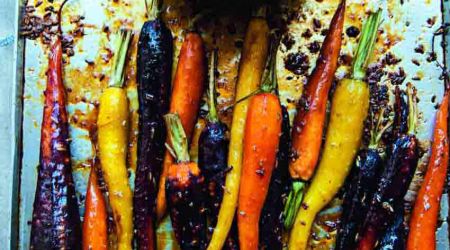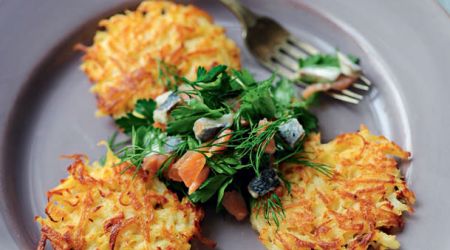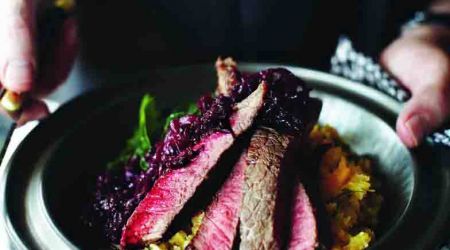Swede
The humble swede is enjoying its moment in the culinary spotlight. After being championed by top-class chefs for its distinctive flavour and texture, this root vegetable is assuming its rightful place on fine-dining menus, writes Michael Raffael with recipes by Linda Tubby
When is a turnip not a turnip? Answer: when it’s a swede. No, this isn’t a bad joke left over from a Christmas cracker. The culinary border between these two vegetables is indistinct. To add to the confusion, swede is listed on some pickle jar labels in the UK as ‘rutabaga’. This is a corruption of rotabagge (root bag), its old Scandinavian name, and one, incidentally, that Americans still use.
The swede is a cross between a turnip and a cabbage. It reached Britain from Sweden about 300 years ago. Nobody is sure quite when, but it seems the Scots took to it before the English. They already had a history of cooking with turnips: ‘Boil them in plenty of water for three-quarters of an hour to nearly two hours according to the age and size.’ The Scottish Cook and Housewife’s Manual, published in 1827, goes on to recommend mixing powdered ginger with mashed turnips – ‘the yellow, sweet juicy sort for which Scotland is celebrated.’ The author adds that turnips had once been popular as an appetiser, eaten raw before dinner. For mash, simply bash, and you have one part of the holy Burns Night trinity: haggis, tatties (potato) and neeps (swede).
While, north of the border, swedes were en route to one kind of culinary immortality, in Cornwall they were bound for another. They were a favoured veggie in tin miners’ pasties and, over time, they became an essential part of the recipe. Now this recipe has been granted protected status by the European Commission, meaning that every Cornish pasty has to contain some swede. This should be straightforward, but isn’t. Pasty-makers can call swede ‘turnip’ on the ingredients list, but they can’t substitute one for the other. Conceivably, a ‘Swedish pasty’ could contain turnip but no swede.
So, going back to its roots, what makes a swede different from its kissing cousin? Well, for one thing, it’s larger. After being left in the ground to mature, it can grow to weigh several kilos. Its outer skin, in common varieties, is a dirty aubergine colour. Peel it and it’s yellow-fleshed. Cook it and it deepens to orange. Although the ‘two hours’ boiling recommended by The Cook and Housewife’s Manual is exaggerated, swede does take longer to cook than most other root vegetables. However, it doesn’t go soft as a carrot when simmered for hours in a casserole. Its taste remains upfront and dominant. Recognising its distinctive flavour, The Cook and Housewife’s Manual suggests serving swede with ‘boiled fowl or veal, or the more insipid meats’.
Their pungency may be due to the way they’re cultivated. Swedes grow slowly and can lie in the ground for more than six months before they’re picked, twice as long as, say, a mature carrot. Gardeners will often leave them to over-winter in the ground rather than harvest and store them.
If swedes have been slow to make it onto the list of fashionable foods, it’s probably the fault of the French. André Simon, who co-founded the Wine & Food Society in the 1930s, was typically sniffy about swedes. In his Concise Encyclopaedia of Gastronomy, he wrote that they were mostly grown for cattle food. When Germany occupied France during World War II, it requisitioned the potato crop, forcing the population to ‘manger des rutabagas’. That memory has never faded. Until Alain Passard, of the three-starred L’Arpège in Paris, introduced them on his vegetable menus, no Gallic chef would ever have dared to serve them.
Edinburgh chef Tom Kitchin has no such qualms. Whether it’s for a Burns Night dinner or on a daily basis, Tom is comfortable about dressing swede aka turnip. If he intends mashing it, he minces his swede before cooking it. Apart from butter and pepper, he likes to flavour it with nutmeg. As a variant, Tom sprinkles breadcrumbs on top and bakes it. ‘I like to combine it with other root vegetables,’ he says. ‘I layer it with beets and potatoes, pour over cream and bake it like a gratin Dauphinois.’
Tom also likes to slice a swede thinly and steep it in a sweet and sour pickle for at least a day. But Branston Pickle may have beaten him to this idea by a few decades. Since 1922, it has included swede in its formula. Check the small print on the label and look for rutabaga – it’s listed right there between carrot and cauliflower.
Maybe the future of this neglected-but-rediscovered vegetable on the gastronomic top table lies close to its Scandinavian roots. At Noma, René Redzepi presents it raw as part of a crudités dish. It’s coated with a six-vinegar dressing. Other Danish chefs steam it al dente or combine it with buttermilk. It seems the Scots who were chewing it raw in the days of Bonnie Prince Charlie could have been onto something.
Between its crude and boiled-to-perditio states, the swede has plenty of culinary mileage. It makes good oven-roasted chips or deep-fried crisps. It’s also a standby for winter soups; the young leaves are delicious when wilted with oil and garlic.
Rough, sometimes scaly, often gnarled, swedes will never be things of beauty, but they have a lot more to offer than being mere cattle feed. In fact, any cattle that can get a bit of swede should count themselves lucky.

Recipes
Get Premium access to all the latest content online
Subscribe and view full print editions online... Subscribe




